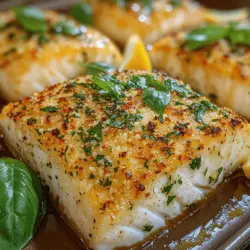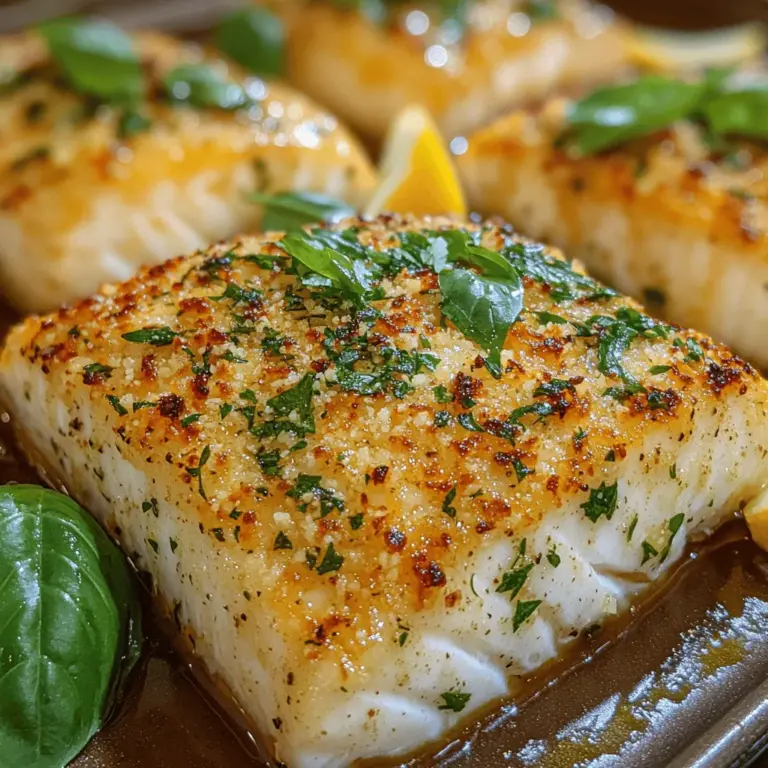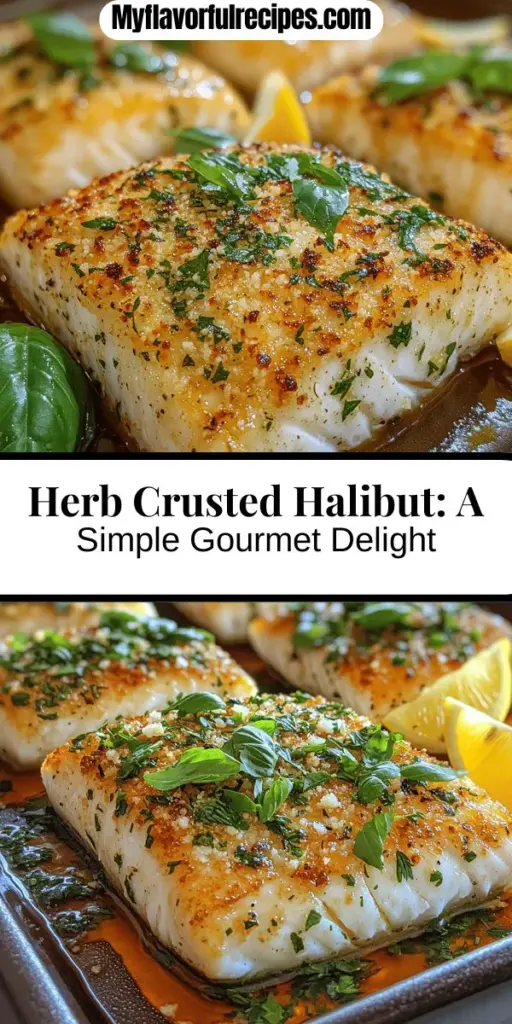Introduction
Halibut is celebrated not only for its delicate, flaky texture but also for its mild flavor that makes it a versatile choice for a myriad of culinary creations. This popular fish, often found in gourmet restaurants, is equally well-suited for home cooking, making it a beloved option for both weeknight dinners and special occasions. When paired with a vibrant herb crust, halibut transforms into a dish that is as visually appealing as it is delicious. The herb crust not only enhances the flavor profile of the fish but also adds a delightful crunch that contrasts beautifully with the tender flesh of the halibut.
This Herb Crusted Halibut recipe is designed to bring the restaurant experience into your kitchen, allowing you to impress your family and friends with minimal effort. The aromatic blend of fresh herbs, breadcrumbs, and spices creates a mouthwatering crust that elevates the dish, making it a perfect centerpiece for any meal. Whether you’re celebrating a special occasion or simply indulging in a nutritious weekday dinner, this recipe is sure to become a staple in your culinary repertoire.
The Nutritional Benefits of Halibut
Halibut is not just a delicious choice; it is also a highly nutritious one. As a lean protein source, it provides a substantial amount of protein while being low in calories, making it an excellent option for those looking to maintain a healthy diet. A typical serving of halibut offers around 22 grams of protein, which is essential for muscle repair and growth, as well as overall body function.
One of the standout features of halibut is its rich content of omega-3 fatty acids. These essential fats are known for their numerous health benefits, including reducing inflammation, supporting heart health, and improving brain function. Regular consumption of omega-3s has been linked to a lower risk of chronic diseases such as heart disease and stroke. In addition to omega-3s, halibut is a good source of vitamins and minerals, including vitamin D and selenium, which play vital roles in bone health and immune function.
When compared to other fish varieties, halibut holds its own in terms of nutritional value. While some fish, such as salmon, may contain higher levels of omega-3 fatty acids, halibut provides a balanced option that is lower in fat and calories. This makes it an excellent choice for those seeking to incorporate more fish into their diet without the added calories that come with fattier fish.
Key Ingredients for Herb Crusted Halibut
To create the perfect Herb Crusted Halibut, it is essential to select high-quality ingredients that will enhance the dish’s flavor and texture. Here’s a closer look at the key components of this recipe:
Halibut Fillets
When sourcing halibut fillets, freshness is paramount. Look for fillets that have a clean, ocean-like smell and firm, translucent flesh. The color should be a pale, off-white hue, and the fillets should be free from any dark spots or discoloration. If possible, purchase halibut from a reputable fishmonger or grocery store that prioritizes sustainability. Frozen halibut is also a viable option, as it is often flash-frozen at sea to preserve its freshness.
Fresh Herbs
The herb crust is the star of this recipe, and using fresh herbs is crucial for achieving the best flavor. A combination of parsley, basil, and dill brings a vibrant, aromatic quality to the dish.
– Parsley adds a fresh, slightly peppery flavor that balances well with the richness of the fish.
– Basil contributes a sweet, aromatic note that enhances the overall taste profile.
– Dill imparts a subtle anise flavor that pairs wonderfully with seafood.
Using fresh herbs instead of dried ones will ensure that your herb crust is bursting with flavor.
Breadcrumbs
For the perfect crunch, panko breadcrumbs are the preferred choice. These Japanese-style breadcrumbs are lighter and airier than traditional breadcrumbs, resulting in a crispier texture when baked. They also absorb less moisture, helping to maintain the integrity of the crust while preventing it from becoming soggy.
If you prefer a gluten-free option, you can easily substitute panko with gluten-free breadcrumbs, which are widely available in most grocery stores.
Parmesan Cheese
Adding grated Parmesan cheese to the herb crust enhances its flavor and adds a savory depth that complements the halibut. The cheese melts slightly in the oven, creating a golden, crispy layer on top of the fish. For those who are lactose intolerant or prefer an alternative, nutritional yeast can be used as a substitute, offering a similar umami flavor without the dairy.
Garlic
Garlic plays a pivotal role in infusing the herb crust with flavor. Its aromatic qualities enhance the overall dish, while also providing various health benefits, such as boosting the immune system and promoting heart health. Fresh garlic is recommended for this recipe, as it offers a more robust flavor compared to pre-minced varieties.
Olive Oil
Finally, selecting a high-quality extra virgin olive oil is essential for achieving the perfect herb crust. Olive oil not only helps the breadcrumbs adhere to the fish but also contributes to the overall flavor. Look for olive oils that are cold-pressed and have a fruity aroma, as these qualities indicate higher quality. Avoid oils with a musty or rancid smell, as they can negatively impact the dish.
Preparing Your Herb Crusted Halibut
Now that you have gathered all the necessary ingredients, it’s time to prepare your Herb Crusted Halibut. Follow these step-by-step instructions to create this delightful dish:
1. Preheat the Oven: Begin by preheating your oven to 400°F (200°C). This ensures that the fish will cook evenly and develop a crispy crust.
2. Prepare the Herb Mixture: In a mixing bowl, combine the fresh parsley, basil, and dill. Add the panko breadcrumbs, grated Parmesan cheese, minced garlic, and a generous drizzle of extra virgin olive oil. Mix the ingredients together until they are well incorporated and the breadcrumbs are evenly coated with oil. This step is crucial for ensuring that the herb crust adheres well to the halibut and achieves the desired texture.
3. Season the Halibut: Pat the halibut fillets dry with paper towels to remove any excess moisture. This will help the herb crust stick better. Season both sides of the fillets with salt and pepper to taste. This simple seasoning will enhance the flavor of the fish and provide a well-rounded taste.
4. Coat the Fillets: Place the seasoned halibut fillets on a baking sheet lined with parchment paper or lightly greased with olive oil. Using a spoon or your hands, generously press the herb mixture onto the top of each fillet, ensuring that they are evenly covered. The more herb crust you apply, the more flavorful and crispy the halibut will be.
5. Bake the Halibut: Once the fillets are coated, place the baking sheet in the preheated oven and bake for approximately 12-15 minutes, or until the fish is opaque and flakes easily with a fork. The cooking time may vary slightly depending on the thickness of the fillets, so keep an eye on them to avoid overcooking.
As your Herb Crusted Halibut bakes, the kitchen will fill with the tantalizing aromas of fresh herbs and garlic, whetting your appetite and preparing you for a delightful dining experience.
Stay tuned for the next part of this article, where we’ll explore additional tips for achieving the best results and address common questions about this delectable dish.
{{image_1}}
Importance of Drying and Seasoning the Halibut Fillets
When preparing halibut for an herb crust, the first and most crucial step is to ensure that the fish is properly dried and seasoned. Moisture can prevent the herb crust from adhering effectively and can lead to a soggy texture once baked. To dry the halibut fillets, use paper towels to gently pat them down on both sides. This not only helps the crust to stick better but also aids in achieving that desirable golden-brown finish during baking.
Once the fillets are dry, seasoning is key to enhancing the flavor of the fish. A simple sprinkle of salt and freshly cracked black pepper on both sides will elevate the natural taste of the halibut. This foundational seasoning creates a flavor base upon which the herb crust can build, ensuring that every bite is deliciously seasoned.
Techniques for Applying the Herb Crust Effectively
Applying the herb crust is a critical step that can determine the success of your dish. Begin by preparing the herb mixture, which typically includes a blend of fresh herbs such as parsley, dill, and chives, along with breadcrumbs for texture. To apply the crust, follow these steps:
1. Prepare the Herb Mixture: In a mixing bowl, combine finely chopped fresh herbs with breadcrumbs, olive oil, garlic, lemon zest, and any additional spices you desire. The olive oil helps to bind the mixture and creates a cohesive layer on the fish.
2. Dredge the Fillets: Place the seasoned halibut fillets side by side on a clean cutting board. Use your hands or a spatula to gently press the herb mixture onto the top of each fillet. Ensure that the crust is evenly applied, covering the entire surface for maximum flavor and texture.
3. Let it Rest: After applying the crust, let the fillets sit for a few minutes. This allows the crust to adhere better to the fish and helps the flavors meld together.
Tips for Achieving a Perfectly Baked Fish
Baking halibut to perfection involves a few essential tips. First, ensure that your oven is preheated to the right temperature—around 425°F (220°C) is ideal for achieving a crispy crust while cooking the fish through.
1. Use a Baking Sheet: Line a baking sheet with parchment paper or lightly grease it to prevent sticking. This will also make cleanup easier.
2. Space the Fillets: Place the herb-crusted halibut fillets on the baking sheet, ensuring there is enough space between each piece. This allows for even heat circulation and promotes browning.
3. Monitor the Cooking Time: Halibut typically cooks quickly, with an average baking time of about 12 to 15 minutes, depending on the thickness of the fillets. Check for doneness around the 10-minute mark to prevent overcooking.
Ideal Baking Temperature and Time
The ideal baking temperature for herb-crusted halibut is 425°F (220°C). At this temperature, the crust will become crispy while the fish remains moist. As a general rule, plan for approximately 12 to 15 minutes of cooking time for every inch of thickness of the fillet.
Recognizing Doneness: Visual and Textural Cues
To determine if your halibut is done, look for a few key visual and textural cues:
1. Color: The herb crust should be golden brown, indicating that it has cooked properly and developed flavor.
2. Flakiness: Use a fork to gently poke into the thickest part of the fillet. If it flakes easily and appears opaque, it’s a good sign that it’s cooked through.
3. Internal Temperature: For precise measurement, the internal temperature of the halibut should reach 145°F (63°C). If you have a meat thermometer, this is the most accurate way to check doneness.
Serving Suggestions
When it comes to serving herb-crusted halibut, consider pairing it with dishes that complement its delicate flavor. Here are some creative ideas:
– Light Salads: A refreshing arugula salad with a citrus vinaigrette pairs beautifully with the fish. The peppery notes of arugula and the acidity of the vinaigrette balance the richness of the halibut.
– Roasted Vegetables: Roasted asparagus or Brussels sprouts seasoned with olive oil, salt, and pepper make for a vibrant and nutritious side. The caramelization of the vegetables enhances their natural sweetness, creating a lovely contrast to the savory fish.
– Grain Options: Serve your halibut with a base of quinoa or wild rice. These nutrient-dense grains add a chewy texture and absorb the flavors of any sauce or dressing you might use.
Flavor Variations and Substitutions
Experimenting with different flavors can elevate your herb-crusted halibut even further. Here are some suggestions for altering the herb crust:
1. Incorporate Different Herbs or Spices: While parsley, dill, and chives are classic choices, consider using fresh basil, tarragon, or cilantro for a different flavor profile. Adding spices such as paprika or cayenne can also introduce a hint of warmth.
2. Adding Zest from Other Citrus Fruits: Along with lemon zest, try incorporating lime or orange zest into the herb mixture. This subtle change can brighten the dish and add an exciting twist.
3. Dietary Restrictions: For those with dietary restrictions, there are countless options. Use gluten-free breadcrumbs or crushed nuts as a substitute for traditional breadcrumbs. If you need a dairy-free option, consider using nutritional yeast or a dairy-free cheese substitute to maintain flavor without compromising dietary needs.
Conclusion
Herb-crusted halibut is a simple yet elegant dish that showcases the beauty of fresh ingredients. The combination of a crispy herb crust and moist, flaky fish creates a delightful dining experience that is both satisfying and nutritious. This recipe not only offers versatility in flavor adjustments and side pairings but also encourages home cooks to embrace the joy of cooking.
As you explore this dish, remember to appreciate the process of preparing a meal from scratch. The satisfaction of serving a homemade dish that highlights fresh ingredients is unparalleled. Whether you’re preparing a weeknight dinner or entertaining guests, herb-crusted halibut is sure to impress and become a staple in your meal planning repertoire. Enjoy the culinary adventure of creating this delightful fish dish!



